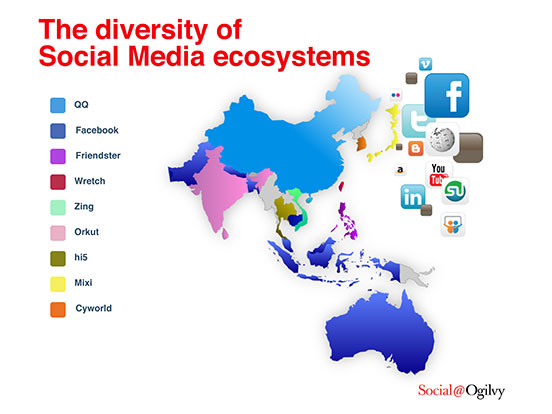
Btrax Design Company > Freshtrax > Chinese Social ...
Chinese Social Media: The Same, but Different – Seminar Summary
I was lucky to attend a noon time seminar called “Social Media In China: The Same, But Different”, hosted by the Stanford Program on Regions of Innovation and Entrepreneurship (SPRIE) and sponsored by MediaX of Stanford University. Thomas Crampton, who oversees Asia Social Media for OgilvyPR 360, gave a talk on the landscape of social media in China to a packed conference room at Stanford University. Crampton has an interesting background as he came from what we call today, traditional journalistic print media, and adapted his career to the “new” social media.
Thomas Crampton started off the seminar in “social” style by encouraging dialog and interaction instead of the same old “I talk – you listen” seminar.
Asia has a very diverse social media ecosystem as shown in the snapshot below:

With this diversity, China has a self-similarity as well as its differences to the rest of the global social media landscape.
The Same
People in China do want to socialize. There are a couple of factors that support that: (1) Most people come from single child households so having online friends is important because their extended family is limited and (2) The college students, like in the US, have adopted Social Media as a way to communicate and socialize with each other.
In fact, he said “Students he interviewed didn’t watch much standard TV broadcasts but spent more time viewing on-line video content.” Asia trends higher overall in terms of hours spent than the US in this area.
Much of the Asian social media diversity is driven by language, culture and the “digital divide” of the haves and have nots. China is no different. Crampton said people in China “appreciate the fact that information access is more available now than in the past.”
The Difference
Crampton brought up some key differences about the China Social Media landscape:
- Even though “C2C” means “Copy 2 China” it isn’t “Copy Exact.” Crampton said “the Chinese really improve on the copy and many features that were incorporated into these “Copy Cat” products years ago are just being adopted by those original companies today.
- Analysis of Chinese digital native or Netizen that most people under 25-30 are digital native where most people older than 25-30 are digital immigration.
- China’s adoption of the internet changes rapidly as the “netizens” every quarter are increasing in the 10s of millions which is a healthy growth rate– Currently 420M and rising.
Thomas Crampton’s view of China paints a different view of what our western view of China seems to be. The Great FireWall is somewhat of misnomer as the products in China seem to be competitive with the standard social web products. Crampton said ” The true measure of success (in China) is the blocked status of a website product.” Internet data in China seems to be skewed so you have to make some judgments based on knowledge of the market. The digital age is just becoming golden in China but aged decision makers in China is keeping the netizen growth at the youth level low. But, with a trend of an ever-growing social market and with a netizen population almost twice that of the population of the US, China is hard to ignore.







